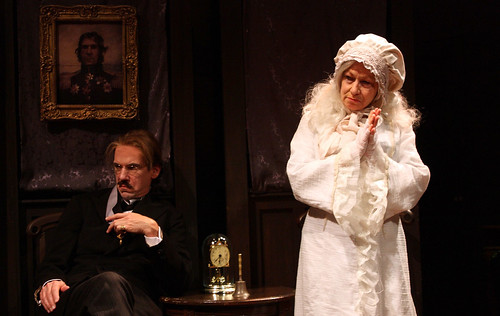Haunting Ghost Sonata kicks off Strindberg cycle
Director Hummel (James Carpenter) crashes a "ghost supper" in the Cutting Ball Theater production of The Ghost Sonata by August Strindberg. BELOW: The Colonel (Robert Parsons) and the Mummy (Gwyneth Richards) regain control after the Director has done his best to ruin them. Photos by Laura Mason
Watching August Strindberg's The Ghost Sonata at Cutting Ball Theater, it becomes clear that without Strindberg, we probably would not have the wonderfully weird worlds of Samuel Beckett or Harold Pinter or Edward Albee or, in the film world, David Lynch or Spike Jonze. Strindberg, though famous for the naturalism of his Miss Julie, pushed into expressionism later in his career and helped redefine modern theater.
During this, the 100th anniversary year of Strindberg's death, Cutting Ball has launched an ambitious celebration of one of Sweden's greatest pre-Abba exports. The Strindberg Cycle collects all five of the chamber plays Strindberg wrote in 1907 that were performed in The Intimate Theater, which had about 150 seats, not unlike the EXIT on Taylor, where Cutting Ball is in residence. This cycle marks the first time all five of these plays have been performed together in an any language. For the real Strindberg fanatics – and this cycle will surely create new members of that category – Cutting Ball offers marathon days (Saturdays and Sundays, Nov. 10, 11, 17, 18) on which you can see all five shows in a row.
If The Ghost Sonata, the first show in Cutting Ball's cycle, is any indication, this is going to be an enjoyably Strindbergian fall in San Francisco.
Like all these plays, Ghost Sonata features a world-premiere translations by Paul Walsh that makes the work immediately accessible and juicy. In addition to the weighty topics like guilt, pain, deception, bad karma, suffering, redemption and death – so much death for an 80-minute play! – we also get secrets and gossip and women living in closets, mysterious deaths and shattering revelations. Remember that horrifically watchable soap opera "Passions," with its blend of the supernatural and the super-cheesy? This is the much more intellectual precursor to that.
Ghost Sonata could be an incredibly dreary experience, but director Melrose, his production team and cast keep that from happening. For each of Strindberg's three scenes, set designer Michael Locher gives us a distinct space within the space – the whole experience seems to transpire in a grand drawing room, somewhat faded by time. But thanks to York Kennedy's colorful and intriguing lights and to the component boxes on Locher's set, we get a street scene, a parlor scene (with a music room visible in the distance) and a final scene that seems to take place half in reality, half in hallucination (the latter half is helped by an eerie sound design by Cliff Caruthers).
Heading the cast is James Carpenter, who appears in all but one of the chamber plays, as Director Hummel, an unscrupulous business man who "ravages people's fates" and is described as "demonically shrewd" and as a "horse thief in the marketplace of humankind." In other words, this is not a nice guy. Now in a wheelchair referred to as the "war machine," Hummel is at the end of his life and wants, in his way, to make amends. So he takes under his wing a young man, Arkenholz (Carl Holvick-Thomas) whose father was ruined as a result of doing business with Hummel. The goal is to match the young man with a sad young woman, Adele (Caitlyn Louchard) so that the young people can escape the wicked web of failure and mistakes made by the older people in their lives.
But it turns out that Hummel is also planning something bigger and more devastating. "I'm unable to forgive until I've punished," he says.
The targets of his punishment include his former fiancée (Gwyneth Richards), the aforementioned woman in the closet, and The Colonel (Robert Parsons), a man with too many secrets to thrive in the presence of Hummel. There's some surprising humor bubbling up in this production, including David Sinaiko as a butler who seems to have been watching a lot of Peter Lorre movies.
In its last third Ghost Sonata gets very sad as ideals (and lives) are shattered. But somehow in all of this there is liberation of a sort, maybe even a shred of hope.
What's eminently clear, however, is that Strindberg has found an ally in the Cutting Ball Theater and audiences have found a cycle of plays to savor.
[bonus video]
Cutting Ball Artistic Director Rob Melrose, who also directs the Strindberg Cycle, members of his cast talk about this mammoth effort.
Strindberg Cycle Trailer from The Cutting Ball Theater on Vimeo.
FOR MORE INFORMATION
The Ghost Sonata, Part 1 of the Strindberg Cycle, continues through Nov. 18 at the Cutting Ball Theater, in residence at the EXIT on Taylor, 277 Taylor St., San Francisco. Tickets are $10-$50. Call 415-525-1205 or visit www.cuttingball.com.
Part 2 of the Strindberg Cycle, The Pelican and The Black Glove, begins performances Oct. 25. Part 3, Storm and Burned House, begins performances Nov. 1. The cycle continues through Nov. 18.
Chamber play marathons of all five shows are on Nov. 10, 11, 17 and 18. A Festival Cycle pass is available for $75.

